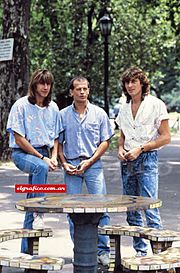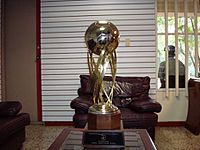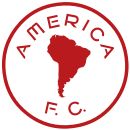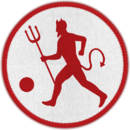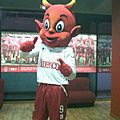América de Cali facts for kids
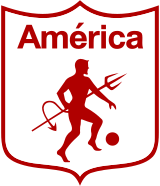 |
||||
| Full name | América de Cali S. A. | |||
|---|---|---|---|---|
| Nickname(s) | Los Diablos Rojos (The Red Devils) Los Escarlatas (The Scarlets) El Rojo (The Red) La Mechita (The Fuse) El Pentacampeón (The Five-Time Champion) La Pasión de un Pueblo (The People's Passion) |
|||
| Founded | 13 February 1927 (officially) | |||
| Ground | Estadio Olímpico Pascual Guerrero | |||
| Capacity | 38,000 | |||
| Owner | Tulio Gómez | |||
| Chairman | Marcela Gómez | |||
| Manager | Diego Raimondi | |||
| League | Categoría Primera A | |||
| 2023 | Primera A, 5th of 20 | |||
|
||||
América de Cali S. A., often called América de Cali or just América, is a professional football club from Cali, Colombia. The team plays in the Categoría Primera A, which is the top football league in Colombia. Their home games are held at the Estadio Olímpico Pascual Guerrero, a very important stadium in the country.
América de Cali is one of Colombia's oldest clubs, officially started in 1927. Its roots go back to the América Football Club, formed in 1918. It's also one of the most successful Colombian clubs, both in Colombia and in international competitions. América has won 15 league titles and one second-division title. They have also reached the finals of the Copa Libertadores four times, including three years in a row from 1985 to 1987. While they haven't won the Copa Libertadores, they have won two other international tournaments: the Copa Simón Bolívar in 1975 and the Copa Merconorte in 1999.
In 2011, América was moved down to the Categoría Primera B, Colombia's second division. This was the first time in their history. They played there for five seasons and returned to the top league after winning the Primera B championship in 2016.
América has strong rivalries with other teams. Their biggest rival is Deportivo Cali, also from Cali. Games between them are called the "Clásico Vallecaucano". Other major rivals include Atlético Nacional, Millonarios, and Independiente Santa Fe.
In 1996, the IFFHS (International Federation of Football History & Statistics) ranked América as the second-best football club in the world. Only Juventus from Italy was ranked higher. América is also considered the best Colombian club of the 20th century. They are ranked as the second-best Colombian team in CONMEBOL club tournaments.
Contents
History of América de Cali
How the Club Started
The story of América de Cali began in 1918. Students from Colegio Santa Librada created a team called América FC. They played against other schools. This early club won one of the first championships in Colombian football, the Copa Centenario Batalla de Boyacá, in 1919. However, the team soon broke up.
Over the next few years, different clubs appeared in Cali with various names. One important club was Racing Club, named after an Argentine team. This club wore light blue and white striped jerseys. But when Racing Club ended in 1925, their uniforms were gone too.
On February 13, 1927, a new club was officially formed. Hernán Zamorano Isaacs was its first president. They chose the name América and picked scarlet and white as their colors. There are different stories about why these colors were chosen. But these colors and the name have stayed with América ever since.
Early Professional Football and a Legend
América won the Amateur Tournament in 1930. They played a match against local rivals Cali FC to decide who would join Colombia's top league. Cali won 1–0 in a game that caused a lot of talk. Two of América's goals were not allowed. This match helped start the strong rivalry between América and what would become Deportivo Cali.
América was banned from the national tournament for a year because they protested the match. So, in 1931, they went on a long tour across Colombia. They played games all over the country and became well-known. For the next 15 years, they were one of Colombia's strongest teams. One of their famous players was Benjamín Urrea, also known as Garabato (the scribble), because he was small and fast.
In 1948, the Colombian league started to become professional. Garabato, who was nearing the end of his career, didn't like this change. Legend says that when América decided to join the professional league, Garabato put a "curse" on the club. He said they would never win a championship. América did struggle a lot in the league, but there were also other reasons for this.
The club didn't have as much money as their rivals. This was especially true during the El Dorado period (1949–54). During this time, Colombian clubs signed many foreign players. América couldn't afford to do the same, so they often finished at the bottom of the league. In the 1950s, they never finished higher than sixth place. They even missed the 1953 tournament because of money problems. The club almost didn't survive the decade. They were saved because another Cali club, Boca Juniors de Cali, closed down instead.
In 1960, the club hired Adolfo Pedernera as manager. Pedernera led the team to a second-place finish in 1961. This was the highest position Los Diablos Rojos had ever achieved. This season changed América's future. They were no longer in danger of closing. By the end of the 1960s, they became one of the strongest teams in Colombia. In 1967, they had a 22-game unbeaten streak and finished third. In 1968 and 1969, they finished second. In 1969, Hugo Lóndero scored 24 goals, a Colombian record. This also qualified América for their first Copa Libertadores in history. Their first Copa Libertadores game was a 2–2 draw against Universidad de Chile on February 18, 1970. Four days later, they got their first win, 1–0 against Rangers.
For most of the 1970s, the club was a solid middle-of-the-table team. They finished second twice. A big moment came in 1976 when América won the Copa Simón Bolívar. This was an international tournament with clubs from several South American countries. But they still hadn't won a Colombian championship.
1979: The First Championship
In 1979, two important things happened for América. First, the club made peace with Garabato. He came to the stadium, attended a special event, and signed a paper "officially" lifting the curse. More importantly, they hired Gabriel Ochoa Uribe as manager. Ochoa Uribe was a very famous manager in Colombia. He had won six championships with Millonarios and one with Santa Fe. During his long time at América (1979–1991), he turned the club into a dominant force in Colombian football.
Ochoa liked defensive football. He built his team with a strong defense, including captain Aurelio Pascuttini. Juan Manuel Battaglia and Gerardo Gonzalez Aquino played in midfield. Jorge Ramón Cáceres and Alfonso Cañón led the attack. In 1979, América was in a close race with Deportivo Cali. Both teams had 34 points. They played two extra games, but both ended in a 0–0 tie. Deportivo Cali won the first part of the season based on goal difference.
In the second part of the year, América finished first in both early stages. This earned them a spot in the final round, a group of four teams. The championship came down to the last game. América needed to beat Unión Magdalena to win the national title. In front of a huge crowd, Los Escarlatas won 2–0. They won their first-ever title on December 19, 1979. This day became known as "Aquel 19" (That 19th).
The Golden Years: Five Titles in a Row
The years 1980 and 1981 were about making the team stronger. The club finished third in both years. They also reached the semi-finals of the 1980 Copa Libertadores. During this time, Ochoa brought in new players. These included Argentine goalkeeper Julio César Falcioni and strikers Roque Alfaro, Humberto Sierra, and Antony de Ávila. Falcioni became a key player for América until 1991. De Ávila played until 1987 and scored a club record 201 goals.
In 1982, all these new players worked perfectly together. Sierra was the league's top scorer with 23 goals. Alfaro added 16 more. América won every Colombian competition that year. They won the first part of the season, their group in the second part, and the final playoff. They secured the title in the last game of the season by beating Millonarios.
América had won two championships with a very strong defense. But in the next break, Ochoa made a move that changed the team's style. Midfielder Willington Ortiz was one of the biggest stars in Colombian football. He had helped Millonarios win two championships in the 1970s. By 1982, he was 30 years old and playing for Deportivo Cali. Even though he was older, he was still a very clever player who could create sudden attacks. Ochoa wanted him for his team and signed him in 1982.
Ortiz's arrival changed América's style from mostly defense to fast attacks. They became known as La Mechita (The Fuse). In 1983, Ortiz and Juan Manuel Battaglia scored a combined 40 goals. Their efforts paid off. América successfully defended their title. They also reached the semi-finals of the 1983 Copa Libertadores. Even better things were still to come.
In 1984, Ochoa made his midfield even stronger by signing Peruvian player César Cueto. He was a creative player known as "The Left-Footed Poet." Midfielder Álex Escobar also started playing regularly for the club. Escobar, who came from the club's youth system, became a key player until 1996. With Cueto, Escobar, and Ortiz in the midfield, La Mechita won their third championship in a row.
In 1985, América aimed for another title. Ochoa added Paraguayan forward Roberto Cabañas and Argentine striker Ricardo Gareca to the team. The season came down to the second-to-last game. América's late win over Deportivo Cali secured their fourth championship in a row. Even more memorable was their exciting journey through the 1985 Copa Libertadores. La Mechita won their first group without losing a game. Then they won their semi-final group to reach the finals against Argentinos Juniors. The Argentine team won the first game 1–0. But Willington Ortiz scored early in the second game, giving América a 1–0 win. This meant a deciding third match was played. After a 1–1 tie, Argentinos won a penalty shootout to lift the Copa Libertadores.
The 1986 season saw América set a Colombian record by winning an amazing fifth straight championship. It was a tough race, but the club managed to hold off Deportivo Cali and win the title. They secured it with a victory over their city rivals. At the same time, they were making another strong run in the 1986 Copa Libertadores. They won their first group (beating Deportivo Cali along the way). They then survived a difficult semi-finals group to reach the championship round for the second year in a row. There, they met Argentine powerhouse River Plate. River won the first game in Cali 2–1. Then they won 1–0 in Buenos Aires to claim their first Copa Libertadores title.
In 1987, the club faced its biggest heartbreak in the Copa Libertadores. Los Diablos Rojos reached the final for the third time in a row. They played against Uruguayan giants Peñarol. América won the first game 2–0 and took an early 1–0 lead in the second game. It looked like the Copa Libertadores was finally coming to Cali. However, Peñarol came back to win 2–1. Then, in an extra playoff match, Peñarol defeated América 1–0 in extra time. It was another very close loss.
Back in Colombia, América's hold on the domestic league finally ended. Millonarios won the title in 1987, breaking América's streak of five championships. Millonarios then won again in 1988. The 1989 season started as if it would be a big battle between the new champions and a strong América. But the season was stopped early due to a tragic event involving a referee.
1990s: More Success at Home
The 1990s started with a very different América team. The core players who had won five championships in a row were gone. Important players like Willington Ortiz and Ricardo Gareca left in 1988. After the 1989 season, Juan Manuel Battaglia retired, and Julio Falcioni went back to Argentina. It seemed like La Mechita was finished.
However, they still had Ochoa as their manager, Alex Escobar in midfield, and Antony de Ávila upfront. In 1990, Sergio Angulo joined De Ávila upfront. Angulo had played well for Deportivo Cali and Santa Fe. Freddy Rincón, a star midfielder for the national team, joined Escobar in midfield. Motivated by their near miss in the stopped 1989 season, the club won the championship in 1990. They won the Apertura, the Finalización, and the playoff tournament. They were champions for the seventh time in club history.
The year 1991 was full of close calls. Atlético Nacional knocked América out of the Copa Libertadores in the quarterfinals. Then, Nacional beat them to the title in the Colombian league. After the season, Gabriel Ochoa Uribe retired as manager. He ended a career that lasted fifteen years and included seven league championships. América hired another famous manager to replace him: Francisco Maturana. Maturana had won the 1989 Copa Libertadores with Atlético Nacional. He also led Colombia to the knockout stages of the 1990 World Cup. He was expected to continue his success with América.
The club won the 1992 Finalización tournament and dominated the playoff stages. They lifted their eighth championship trophy, their second in three years. However, the pain continued in the Copa Libertadores. In the 1992 tournament, they reached the semi-finals again. They played against Newell's Old Boys. Both games ended in a 1–1 tie, so the match went to penalties. After a very long penalty shootout, Newell's won 11–10.
In 1993, Maturana's last year with the club, the team finished fourth in the league. But they still had an impressive run in the Copa Libertadores. They became the first Colombian team to win at Brazil's famous Maracanã Stadium, beating Flamengo. They reached the semi-finals again. But they were denied once more, losing to a last-minute goal from Chile's Universidad Católica.
Maturana left after the season to focus on managing the Colombia national team. Still, the club's successful era continued. They stayed near the top of the Colombian league in 1994, 1995, and 1996. They also qualified for the 1996 Copa Libertadores. That year, América had another great run in the tournament. They made it all the way to the Copa Libertadores finals, where they faced River Plate again. Antony de Ávila scored the winning goal in the first game. In Argentina, however, River Plate won 2–1, with two goals from Hernán Crespo.
Even with the Copa Libertadores disappointment, the 1996–97 season brought some glory to América. The Colombian league format changed that season, making it a very long tournament (16 months). Despite the length, Los Diablos Rojos won their ninth championship. They beat Atlético Bucaramanga in the finals.
Homegrown manager Jaime de la Pava took over in 1998. He continued the club's strong performance. His first title was the 1999 Copa Merconorte, América's second international title. The next year, de la Pava led the club to its tenth title in 2000. They won again in 2001 against Independiente Medellin. They also won the 2002 Apertura against rivals Nacional. This title was a surprise because América had finished eighth in the regular season. However, things soon started to change. De la Pava left after missing the 2002 Finalización finals by just one point.
Challenges in the New Millennium
While the 1990s saw América win three more championships, a new problem began. This problem greatly affected the club's success. América had rumored connections to certain groups that led to financial problems. In 1995, the US government created a special list of businesses suspected of being linked to illegal activities. Under a new rule, American businesses could not do financial deals with those on the list. Over 1,000 Colombian people and businesses were put on this list.
América de Cali and its board members were on this list. Their lives suddenly changed. Transfer fees had to be paid in cash. Visas for tours in the United States were denied. Any money the club had in American banks was frozen. Sponsorship deals ended. Prize money from international tournaments could not be given to the club. América became completely dependent on ticket sales for money.
Because they couldn't pay high salaries or get top players, América had to sell many of its stars. The club started to decline in Colombian football. By 2004, most of the great players from the club's best years were gone. The new players were not as talented. Although the club reached the semi-finals of the 2003 Copa Libertadores and won a championship in the 2008 Finalización tournament, these were brief moments in a long, difficult period. Just a year after winning the league title, América was near the bottom of the league in 2009. They also did poorly in the Copa Libertadores, finishing last in their group without winning a game. The 2010 season was also bad, as América failed to reach the playoffs in both tournaments.
Relegation and Return (2011–2016)
The club's problems reached their worst point at the end of the 2011 season. América finished second-to-last in the relegation table. They had to play a special playoff game against Patriotas. They lost this game on penalties after a 2–2 total score. On December 17, 2011, América was moved down to the Categoría Primera B for the first time ever. They had been in the top league for 57 seasons.
Many expected América to quickly return to the top league. They played very well in the 2012 Primera B season. They didn't lose any games at home. They beat Unión Magdalena on penalties to win the Apertura tournament. However, they didn't play well in the second tournament and didn't reach the final. They then lost the season finals to Alianza Petrolera on penalties. After that, they lost a promotion playoff game against Cúcuta Deportivo by a total score of 5–3.
In 2013, after many years, the club was finally removed from the special list that caused their financial problems. However, 2013 was still a disappointing year for the team. In both tournaments, América finished first in the regular season but failed to reach the finals. In 2014, they made it to the final of the Apertura tournament but lost to Jaguares 5–2. The second tournament was even worse, as the club finished eighth and last in their semi-final group.
In 2016, under manager Hernán Torres, América finished second in the first stage. They then won their semi-final group and reached the finals. On November 27, La Mechita earned promotion back to the Categoría Primera A. This happened after five seasons in the second division. They won 2–1 against Deportes Quindío in the last game of the semi-final stage. Goals from Ernesto Farías and Cristian Martinez Borja secured their return. In the tournament's final, they beat Tigres 5–1 and won their first Primera B title.
Return to Top League Success
In their first season back in the Primera A, América played well. Even though they were in danger of being relegated for much of the season, they qualified for the Copa Sudamericana. This was their first international competition in several seasons. The team finished seventh in the Apertura tournament and reached the knockout stage. They were eliminated by city rivals Deportivo Cali in the semi-finals. In the Finalización tournament, the team finished sixth and were again eliminated in the semi-finals, this time by Millonarios. In their return to international play, they were knocked out of the 2018 Copa Sudamericana in the first round by Argentine team Defensa y Justicia.
In both tournaments of the 2019 season, América played very well. In the Apertura tournament, the team finished fourth in the first stage. They were third in their semi-final group. They beat Millonarios in the last game, stopping them from reaching the final. They then won their fourteenth league title in the Finalización tournament, their first in 11 years. Manager Alexandre Guimarães led the team, with strikers Michael Rangel and Duván Vergara playing key roles. The team finished second in the first stage. They then won their semi-final group, ahead of Deportivo Cali and Santa Fe. In the final, Los Diablos Rojos faced Junior. They won 2–0 over two games to win the championship. This also secured their return to the Copa Libertadores for the 2020 edition after an 11-year break.
The 2020 season started with the return of club legend Adrián Ramos. América also returned to the Copa Libertadores. Their campaign began with a loss to Grêmio at home. They then won 2–1 against Universidad Católica in Chile. Both the league and international competitions were then stopped due to the COVID-19 pandemic. The club could not agree on a new contract with Alexandre Guimarães, so he left in June. Juan Cruz Real took over as manager for the rest of the season. Games started again in September. América lost the 2020 Superliga Colombiana to Junior. The team also failed to get past the group stage of the Copa Libertadores. They tied 1–1 with Grêmio in their last game, which also stopped them from moving to the Copa Sudamericana. Even with the Copa Libertadores disappointment, América had another great league run. They won their 15th league title, their second in a row. They beat Santa Fe in the finals with a total score of 3–2 over two games.
In 2021, América de Cali reached the knockout stages of the Apertura tournament. They lost to Millonarios in the quarter-finals. However, they failed to get past the group stage of the Copa Libertadores. This led to Juan Cruz Real leaving his job as manager. Juan Carlos Osorio was hired for the Finalización tournament and the knockout stages of the Copa Sudamericana. They were beaten by Athletico Paranaense in the round of 16. Their league performance was mixed. They lost another Superliga to Santa Fe. But they qualified for the semi-finals of the Finalización tournament. They finished eighth after a big 5–1 win against Deportivo Pereira. They were eliminated from the title race in their semi-final group. However, their overall performance in the season earned them a spot in the 2022 Copa Sudamericana. Osorio continued as manager in 2022. But he was fired after a few games due to poor results and disagreements with the club's owner. They were also knocked out of the Copa Sudamericana early. Alexandre Guimarães returned as manager. But the team failed to reach the Apertura semi-finals. They were also knocked out of the Copa Colombia. In 2023, América reached the semi-finals in both tournaments but were eliminated both times.
Team Uniforms
Home Uniform
In its early years, América wore blue and white uniforms. These were based on the colors of the Argentinian team Racing Club. The club later changed to its famous red and white colors, which became permanent in 1931. A club story says that the idea came from a basketball game. Club secretary Hernando Lenis saw a basketball team called "The Red Devils" and was very impressed. That game inspired both the club's jersey and their nickname, Los Diablos Rojos (The Red Devils).
Away Uniform
Throughout its history, América de Cali has had several different away uniforms. Most of these have been white with red. But sometimes they have worn black or blue. One well-remembered away uniform had red shorts with a white shirt. The club has also worn special uniforms for celebrations. For example, in 1958, they wore a uniform similar to Racing Club's, honoring their very first uniform.
Third Uniform
The club also has a second alternative jersey, which is black. They started wearing this in mid-2006.
Club Crest
The club's first crest appeared in the mid-1930s. This crest showed a map of South America, referring to the team's name, América F.C.. It was used until 1939.
The devil first appeared on the crest in 1940. This was because people believed the players "played like devils" on the field. During Gabriel Ochoa Uribe's time as manager, the devil symbol was sometimes removed for religious reasons. So, the crest would only show the number of stars, which represented the titles the club had won.
In 1992, the devil was completely removed from the main crest. It was only used for the club's business side. But to celebrate the club's 70th anniversary, the devil was put back on the uniforms. Since then, any negative beliefs about the devil symbol have been removed. In 2007, to celebrate the club's 80th birthday, the devil was temporarily replaced with a logo that said "80 años" (80 years) and "1927–2007." Above the crest were the 13 stars for the titles won. In 2010, the devil returned to the crest on the shirts made by Saeta, the uniform sponsor at the time.
Since 2017, the club uses a crest without stars. This follows a global trend in professional football where teams show only their main badge without graphic references to their wins.
Club Mascot
The mascot for América de Cali is a red devil. This came about because sports journalists in the 1930s said the club's players looked like red devils running on the field. This led the club to adopt the devil as its symbol.
Home Stadium
Estadio Olímpico Pascual Guerrero
Team Rivalries
América de Cali vs. Deportivo Cali
This rivalry is known as El Clásico Vallecaucano (the Valle del Cauca derby). These two teams are fierce, long-time rivals for being the best in the city of Cali. The rivalry started in a local football tournament in 1931. Deportivo Cali won 1–0 in a controversial game where two of América's goals were not allowed. América protested, and the club was banned from local tournaments for a year. The rivalry has only grown since then. The clubs have played 335 times. Cali has won 125 games, and América has won 104. They have tied 106 times.
Together, both teams have won 25 league titles. They have played three championship deciding games. Deportivo Cali won one in 1969, while América won in 1986 and 1992. Usually, between 30,000 and 35,000 fans attend this match at the stadium.
América de Cali vs. Atlético Nacional
This rivalry is called the Clásico Popular ("People's Classic"). It involves the two Colombian clubs with the most fans. It became important in the 1980s when both América and Atlético Nacional started to do well in local and international tournaments. The rivalry was strongest between 1990 and 2002. During this time, both teams were among the most powerful in Colombian football. They met 15 times in championship finals, most recently in 2002. The clubs have also played 11 times in the Copa Libertadores and twice in the Copa Sudamericana. This is a very close rivalry. América has 93 wins, Nacional has 98, and they have tied 80 times.
América de Cali vs. Millonarios
This rivalry started in the late 1970s and became strong in the 1980s. It's known as the Clásico de las Estrellas (Classic of the Stars). This is because Millonarios and América won the most league championships (called "stars") when only one championship was given each season (1948–2001). These two teams are very popular and successful in Colombia. Together, they have 31 league titles (16 for Millonarios and 15 for América). They also have some of the largest and most organized fan groups. The rivalry was at its peak in the 1980s. During that time, América (5) or Millonarios (2) won seven out of nine championships. They were also the main teams in the 1989 season, which was stopped early. This rivalry became less intense in the early 2010s when América faced difficulties and was relegated. However, it became strong again when América returned to the top league.
América de Cali vs. Santa Fe
This is a smaller and more recent rivalry. It began to grow in the late 1980s and early 1990s. During that time, América often bought Santa Fe's best players for low prices. They then used these players to win championships. Some Santa Fe players who moved to América were Eduardo Niño, Wílmer Cabrera, and Sergio Angulo. All these players were part of América's 1990 league title team. This created bad feelings between the two groups of fans. The rivalry's most competitive moment came in 1999. América defeated Santa Fe on penalties in the Copa Merconorte finals. In 2020, they played each other in the season's final games. América won, claiming their fifteenth title.
A sad moment in the rivalry happened on May 11, 2005. A fight between fan groups resulted in one person's death. The game was stopped with América leading 5–2. The rivalry remains intense today, especially for Santa Fe fans.
Club Achievements
| Type | Competition | Titles | Seasons |
|---|---|---|---|
| Domestic | Categoría Primera A | 15 | 1979, 1982, 1983, 1984, 1985, 1986, 1990, 1992, 1996–97, 2000, 2001, 2002–I, 2008–II, 2019–II, 2020 |
| Categoría Primera B | 1 | 2016 | |
| International | Copa Merconorte | 1 | 1999 |
| Copa Simón Bolívar | 1s | 1975 | |
| Regional | Primera Categoría Departamental | 5 | 1931, 1932, 1933, 1934, 1935 |
| Segunda Categoría Departamental | 2 | 1927, 1930 | |
| Copa Centenario Batalla de Boyacá | 1 | 1919 |
- record
- s shared record
Other Awards
Friendly Tournaments
- Torneo ESPN: 2020
- Copa Ilustre Municipalidad de Chillan: 2016
- Copa Campeones de América: 2016
- Copa Ciudad de Antofagasta: 2013
- Noche Escarlata: 2013 & 2016
- Copa Cafam: 2008, 2011
- Copa Sky: 2001
- Copa Ciudad Viña del Mar: 2000
- Copa Municipio de Andalucía: 1998
- Noche Amarilla: 1995
- Trofeo Banco de Crédito e Inversiones: 1986
- Copa Osvaldo Juan Zubeldía: 1982
- Copa Gobernación del Valle: 1979
- Trofeo del Consulado Peruano: 1947
Second Place Finishes
- Categoría Primera A
- Runners-up (7): 1960, 1969, 1987, 1991, 1995, 1999, 2008–I
- Categoría Primera B
- Runners-up (1): 2012
- Copa Colombia
- Runners-up (1): 2024
- Superliga Colombiana
- Runners-up (2): 2020, 2021
- Copa Libertadores
- Runners-up (4): 1985, 1986, 1987, 1996
Current Players
Main Team Squad
|
|
Players on Loan
|
|
World Cup Players
The following players were part of their country's team at the FIFA World Cup while playing for América de Cali.
 Marcos Coll (1962)
Marcos Coll (1962) Jaime González (1962)
Jaime González (1962) Luis Carlos Paz (1962)
Luis Carlos Paz (1962) Rolando Serrano (1962)
Rolando Serrano (1962) Roberto Cabañas (1986)
Roberto Cabañas (1986) Wilmer Cabrera (1990)
Wilmer Cabrera (1990) Alexis Mendoza (1990)
Alexis Mendoza (1990) Freddy Rincón (1990)
Freddy Rincón (1990) Leonel Álvarez (1994)
Leonel Álvarez (1994) Óscar Córdoba (1994)
Óscar Córdoba (1994) Harold Lozano (1994)
Harold Lozano (1994) Wilson Pérez (1994)
Wilson Pérez (1994) Antony de Ávila (1994)
Antony de Ávila (1994)
Team Captains
 Juan Pablo Segovia (2019–2021)
Juan Pablo Segovia (2019–2021) Adrián Ramos (2022–2024)
Adrián Ramos (2022–2024)
Club Presidents
List of América de Cali presidents
Club Records
Club Manager
- List of América de Cali managers
See also
 In Spanish: América de Cali para niños
In Spanish: América de Cali para niños


